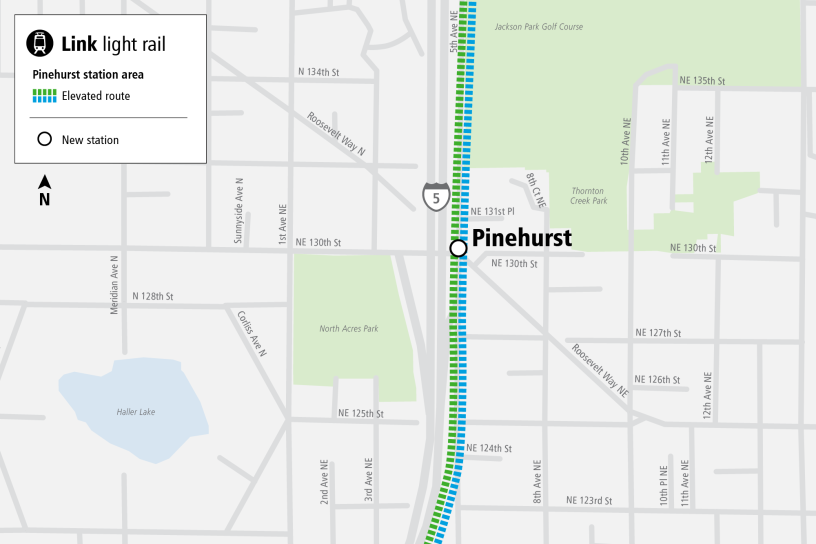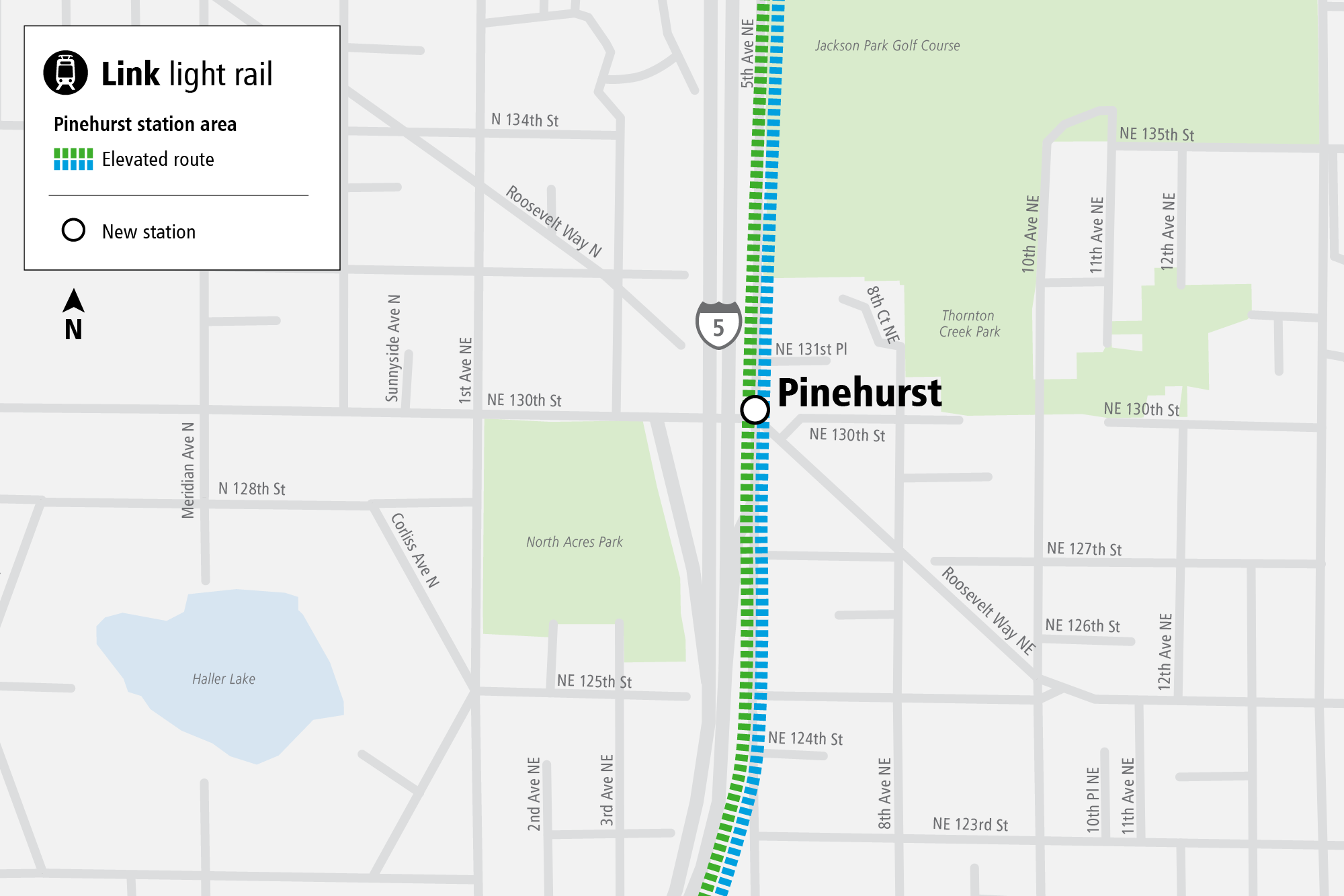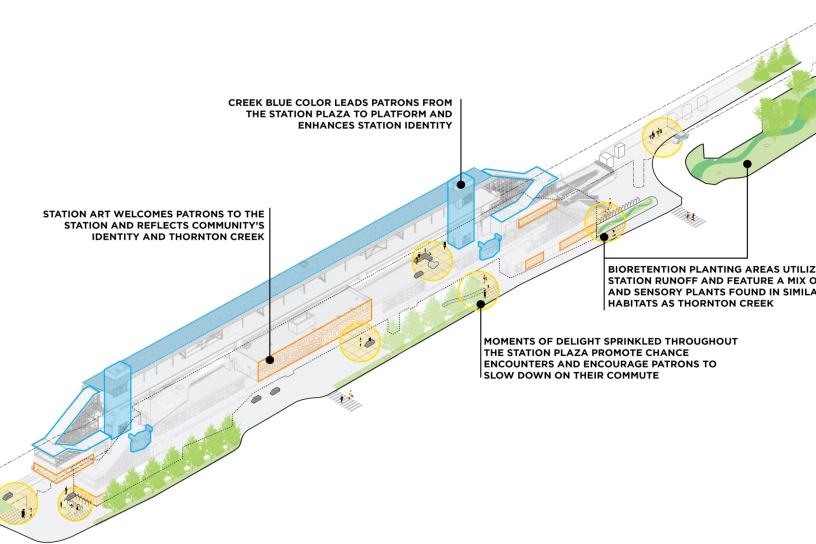

Pinehurst Station project updates
Get the latest in your inbox.
Learn more about Pinehurst Station.
Overview
In 2016, voters approved the addition of the Pinehurst station to the Lynnwood Link Extension at NE 130th Street. The Pinehurst Station will serve a growing residential neighborhood between the Northgate and Shoreline South/148th stations and will be built on the existing Lynnwood Link Extension. The Pinehurst Station is scheduled to open in 2026, and will support approximately 3,400 daily boardings.
Facts
Service: Every 4 - 6 minutes during peak hours.
Travel times:
Pinehurst to Westlake - 15 minutes
Pinehurst to Sea-Tac Airport Station - 53 minutes
Station Design
Station design process
In 2016, voters approved the addition of Pinehurst Station as an infill station to the Lynnwood Link Extension located NE 130th St, to be completed by 2031. In February 2020, the Sound Transit Board authorized staff to complete final design of the station, and in summer 2022 the Board approved additional budget and contract changes for the accelerated delivery of Pinehurst Station. This decision advanced the opening of the new station to Q2 of 2026.
The project team shared 60% designs with the community in fall 2020 to gather input on specific design elements. This feedback was incorporated into ongoing design refinements. Design was completed in coordination with the City of Seattle, King County and the Washington State Department of Transportation including access improvements, right-of-way improvements, and traffic analysis. Sound Transit worked closely with the Seattle Design Commission to review the station design. The remaining permits from WSDOT and Seattle to authorize construction of the station were issued Q3 2023. Construction of final station finishes, station plaza, and nearby roadway improvements began in fall 2023.
Final design features
The station design reflects the unique identity of this neighborhood as an urban oasis, the community’s desire for a modern design, and pride in nearby natural resources of Thornton Creek. The design incorporates bright color and art, seating areas, native landscaping, and natural elements such as stormwater retention features and boulders. Renderings of the final station design are included at the top of this section.
The Sound Transit design team incorporated the feedback we received in fall 2020 to the final station design. Community members were asked to share their preferences for color, seating, and bollards. The blue color preferred by the community was used extensively throughout the station finishes, associated specifically with points of vertical circulation (stairs, elevators, and escalators). The seating elements include both weathered boulders that reflect the station design’s recognition of nearby Thornton Creek, as well as shaped concrete benches located throughout the plaza areas. The bollards are a modern stainless steel type with a sloped top.
Public art
Artist Romson Bustillo, a Seattle-based artist, is developing designs for the station artwork. Bustillo was born on the island of Mindanao in the Philippines. His layered works and immersive collaborations go back to his Philippine lineage, his South Seattle/Pacific Northwest upbringing, and numerous research travels. An artist selection panel made up of members from the community and of art/design professionals were drawn to the intricate detail in his prints and his inter-disciplinary studio work, and chose Bustillo to create artwork for the Pinehurst Station based on his previous work and his vision for the site.
The elevated station made Bustillo think of the dwellings in his home country from his childhood, and and this reference is one of many in his iconography of patterns that incorporate symbolic elements from his culture, the cultural context of the station and neighborhood, and the people who inhabit it, past and present. Bustillo’s intention is to create an inviting work that conveys an optimistic future, and that supports story-telling, encourages discovery, and contributes to wayfinding.
At the south entrance, where the majority of passengers will enter the station, painted artwork will turn the guideway column into a beacon that welcomes passengers as they approach the station. Bustillo’s design narrative will guide passengers as they enter and exit the station and make their way to the ticket vending machines and to the platforms. His artwork will be translated into richly colored, porcelain enamel panels that wrap around the entrances and into both north and south lobbies. The service building, in the center of the station, will also be covered on its east-facing side with a 100-foot-long mural of porcelain tiles, featuring another variation of patterns and colors.
Romson Bustillo presented to the City of Seattle’s Public Art Advisory Committee on Oct. 24, 2024 to walk through some updated renderings of the artwork that is installed over the station finishes at both the north and south entrances as well as the central plaza artwork.
“My approach is informed by research, the location of the station, its immediate environment and fauna, commuters, and community workshops held. I’ve considered how the monumental scale of this project allows for both intimate and communal visual experiences.”
“I’m working on creating a bank of “glyphs” and patterns that will allow commuters and neighbors to play with creating and finding narratives within the artwork. Visual cues will support wayfinding and draw pedestrians to the station entrances.”
- Romson Regarde Bustillo





















